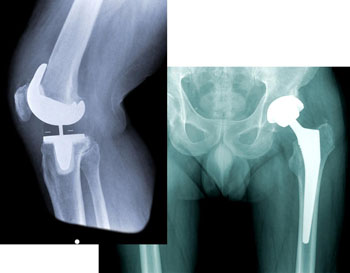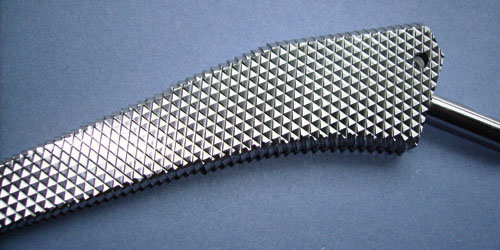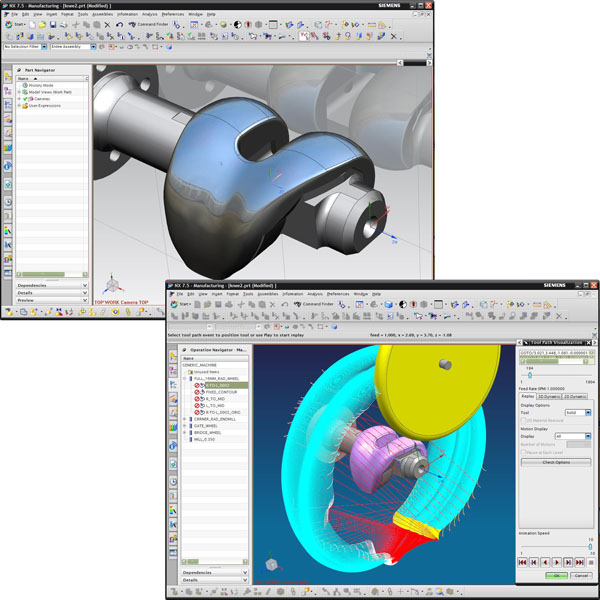E-Sharp News
July 2010
Should I grind knee and hip implants?
The Global Financial Crisis of 2008-09 took its toll on many tool and cutter manufacturers worldwide, forcing some to reduce output by 50-80%. In the aftermath of such economic downturns, many companies looked at diversification strategies to better insulate themselves from volatile economic conditions. Diversification strategies ideally involve investment opportunities that yield high returns in a high growth market with solid “recession-proof” economic foundations.

For this reason, the field of Medical Orthopedic Implant grinding has become an attractive diversification strategy for existing and new players in the CNC tool cutting business. Joint reconstructive surgery is largely dominated by knee, hip and shoulder procedures, all of which involve orthopedic implants and associated instrumentation that typically require grinding during the manufacturing process.
Growth and technological advances in this area are opening doorways of opportunity for grinding shops wanting to enter the lucrative market of implant grinding, which has strong historical and projected growth. Investment into the right technology is crucial to remain competitive in this evolving market. The right machine tool for implant grinding coupled with industry leading CAD/CAM software provides the tools to effectively respond to this market’s needs.
Important grinding routines for orthopedic applications, such as knee implants and bone rasps, are commonly produced using CAD/CAM packages such as Siemens PLM NX . Machine NC programs are typically generated using an NC Post-Processor for a specific machine target and are then used to manufacture the part. The post-processor forms an integral part of the integration between the CAD/CAM software and the machine. It is therefore important to ensure that this integration allows maximum flexibility during the design and production process.
Satisfying geometry and surface-finish requirements when grinding orthopedic-grade alloys for medical implants can prove challenging. Integration between the CAD/CAM software and machine should ideally allow for easy and flexible programming of wheel-dressing routines as well as freedom to select various roughing and finishing grinding wheel geometries. A clear distinction should exist between the role of the CAD/CAM system and machine to avoid inefficiencies that arise when grinding-process changes require NC program regeneration from the CAD model.
In 2008, the global orthopedics market was estimated to be worth approximately US$37 billion [1], of which, US$12.2 billion [2] is made up of the joint reconstruction sector (i.e. artificial implants). Knee and hip reconstruction largely dominates the joint reconstruction sector and therefore is the most relevant for CNC grinders as these joints, as well as associated instrumentation such as bone rasps/broaches, are often manufactured on CNC grinding machines.
Hip and knee arthroplasty has generally seen consistent double-digit revenue growth since the early 2000s and the global joint reconstruction market is expected to grow by more than 9% annually [2] in the coming years. Although not the fastest growing orthopedic market sector, the demand for knee and hip replacement procedures is the highest worldwide [3].

Femoral bone rasp used in hip joint replacement surgery
Underpinned by various social and demographic trends, growth in this sector is virtually guaranteed. Apart from an ageing population with improved access to these medical procedures, growth is fuelled by developing countries such as India and China which represent 37% of the global population combined. To highlight this growth potential, consider that the U.S and Europe are currently the largest market consumers, representing approximately 80% of consumption (50% U.S, 30% Europe) [4] however constituting only 17% of the global population. In 2008, the knee and hip sector saw revenue growth of more than 17% outside the United States which was more than double the amount of growth within the United States [5].
The past decade has seen significant technological advances in the joint reconstruction sector. A new trend emerging from these advances, particularly in the area of knee arthroplasty, is the development of patient-specific implants. Using 3D scanners and sculptural computer-aided design (CAD) technology, patient-specific implants can now be designed and manufactured with increased efficiency and reduced cost compared to just a few years ago. This approach to orthopedic implants has obvious benefits compared to the current use of off-shelf implants that generally consist of a limited range of geometries.
Why should I use a CNC tool grinder for my orthopedic implant grinding requirements?
The evolution and growth of the orthopedics implant market fuels innovation into new products and manufacturing processes. As the market moves towards gender and patient-specific implants, manufacturers must ensure they employ the most cost-effective and viable manufacturing processes available. With the annual number of knee replacement procedures numbering in the hundreds of thousands and growing, coupled with the need to replace superseded manufacturing technologies, it is not difficult to see how market demand is creating new opportunities.
Manual machining of orthopedic implants has been gradually superseded by CNC grinding over the past eight years. Software developments in the areas of CAD/CAM post-processing are providing significant productivity improvements and resulting in new CNC implant grinding solutions entering the market in recent years. This has led to a reduction of manufacturing lead times, allowing patient-specific implants to become a viable business with associated profit margins that custom orthopedic implants command.
Integration between 5-axis CNC tool grinders and CAD/CAM software has provided an efficient solution to the challenges presented by the orthopedic implant market. Flexibility, productivity, automation, and integration with leading CAD/CAM systems are key competencies to identify when investigating potential solutions.
Why is an ANCA tool and cutter grinder the best choice for manufacturing knee and hip implants and orthopedic bone rasps and reamers?
ANCA, an industry leader in CNC tool grinding, has been providing grinding solutions to the cutting tool industry for over a quarter of a century and have since built a strong reputation for delivering customised grinding solutions. Over the past several years ANCA have developed a solution for grinding CAD designed parts from Siemens PLM NX CAD/CAM software by working with global leaders in the field of orthopedic implants as well as other industries.

Using a CAD model of a knee implant, the grinding path is
defined within the Sieman's PLM NX software
The ANCA solution to orthopedic implant grinding provides key competitive advantages over existing systems. By clearly defining the core responsibilities between Siemens NX and ANCA’s Toolroom software, a post-processor has been developed that allows optimum integration between the two systems. The post-processor generates the grinding path information in a generic way so that all process related tasks are delegated to the ANCA software.
The logical separation of the grinding path generation with the manufacturing process inherently introduces several advantages. The grinding path generation from the CAD/CAM system only needs to be generated once. This is then used on the machine where different diameter wheels can be used for roughing, finishing and sparkout operations, all using the same generated data. Wheel dressing seamlessly fits into this system without needing to return to the CAD/CAM system. The ANCA CNC’s 3D-CRC (cutter radius compensation) feature automatically calculates the modified grinding path, adjusting for the new wheel diameter on the fly. This allows parts to be ground using conventional or super-abrasive wheels using the same generated NC code.
This approach eliminates the need to regenerate the NC code from the CAD/CAM software when process parameters need adjusting. Adjustments and compensations can be made to the grinding path and wheels directly on the machine. NC code regeneration is required only when changes need to be made to the part’s geometry. By avoiding the need to revisit the CAD model, the production process is significantly optimised.
Further benefits include the use of ANCA’s industry leading Toolroom software suite. ANCA’s iGrind tool-design software allows the generated NC code to be used in a dedicated iGrind operation, allowing all process parameters to be defined. This allows mixing of CAD generated operations with other standard grinding operations, allowing full flexibility in designing special parts. This approach also allows milling and drilling operations to be performed on one machine and in one set-up, if required.
Seamless integration of the CAD generated geometry into ANCA’s iGrind software also means that the entire implant grinding sequence, including any additional operations, can be simulated in 3D using ANCA’s industry leading Cim3D software. Apart from offline geometry verification, potential collisions can be detected and cycle time estimation calculated.
The ANCA TX7+ is the ANCA machine of choice for orthopedic implant grinding. Built upon a polymer concrete base for superior vibration dampening, the TX7+ provides the envelope, rigidity, accuracy, power, and automation options to tackle the most demanding tasks. The TX7+ features a 37KW (49HP) 10,000RPM spindle as well as a 3000RPM headstock dresser with additional provisions for a secondary rigidly mounted dresser with quick-change HSK arbours. The optional P-Axis provides CNC controlled tool support, including optional steady, Arobotech or CNC force controlled tailstock. The ANCA TX7+ is the ideal orthopaedic implant grinding machine with its inbuilt dual wheel-pack exchanger, or an optional wheel-pack exchanger model is available with up to 21 wheel-packs. Automatic white-sticking is also available.
Automation for orthopedic implant grinding applications typically benefit from the use of a Fanuc robot loader. Apart from providing automatic part loading capabilities, the robot can be utilised to concurrently perform secondary tasks, such as polishing, within the loader envelope while the machine is grinding.
The ANCA solution provides the flexibility to grind a wide range of parts and cutting tools, ensuring maximum machine utilisation and versatility. Apart from orthopedic implants and instrumentation, standard cutting tools can be manufactured using the same machine. In a competitive market, investing in the right machine tool powered by leading software capabilities is a crucial step towards being successful, particularly in the field of orthopedic implants and instrumentation.
Call your local ANCA branch or dealer today and book a demonstration to see for yourself why the ANCA TX7+ is the industry’s machine of choice for grinding orthopedic implants and medical instrumentation.
References
1 The Complete Guide to the Global Orthopaedic Market 2009, Espicom Business Intelligence (www.espicom.com), 2009.
2 The Future of the Orthopedic Devices Market to 2012, Global Markets Direct, Dec-2008, Report Code: GMDME0754MR
3 Global Orthopaedic Market - Focus on Hip and Knee replacement, A&M Mind Power Solutions, Jan 2010,
4 Hip and Knee Replacement Market: Overview of the US and European markets - growth in a mature market, Datamonitor, Oct 2006
5 For Orthopedic Devices, the Future Is Still Bright, Anthony G. Viscogliosi, Viscogliosi Bros LLC, May 2009
6 July 2010